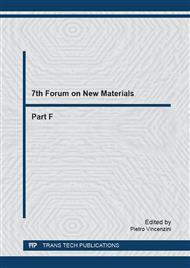[1]
SINCLAIR D. & La MER V.K. Light Scattering as a measure of particle size in aerosols – The production of monodisperse aerosols. Chemical Reviews, v. 44, n. 2, pp.245-267. (1949).
DOI: 10.1021/cr60138a001
Google Scholar
[2]
BOGUSH G.H. & ZUROSKI C.F. Studies of the kinetics of the precipitations of uniform silica particle through the hydrolysis and condensation of silicon alkoxides. Journal of Colloids and Interface Science. v. 142, n. 1, 1-18, (1991).
DOI: 10.1016/0021-9797(91)90029-8
Google Scholar
[3]
GOUTAM B.K. & GANGULI D. Hydrolysis-condensations reactions of TEOS in the presence of acetic acid leading to the generation of glass-like silica microsphere in solution in room temperatture. Journal of Materials Chemistry. v. 10, pp.2289-2203, (2000).
DOI: 10.1039/b003221m
Google Scholar
[4]
SCHMIDT H., SKOLZE H. & KAISER A. Principles of hydrolysis and condensation reactions of alkoxides. Journal of Non-Crystalline Solids. v. 63, pp.1-11, (1984).
Google Scholar
[5]
BRINKER C.J., KEEFER K.D., SCHAEFER D.W. & ASHLEY C.S. Sol-gel transitions on simples silicates. Journal of Non-Crystalline Solids. v. 48, pp.47-64, (1982).
DOI: 10.1016/0022-3093(82)90245-9
Google Scholar
[6]
LaMER V.K. & DINEGAR R.H. Theory, production and mechanism of formation of monodispersed hydrosols. Jounal of the American Chemical Society. v. 72, n. 11, p.4847 – 4857, (1950).
DOI: 10.1021/ja01167a001
Google Scholar
[7]
LI R., CLARK, A.E., HENCH L.L. An investigation of biactive glass powders by sol-gel processing. Journal of Applied Biomaterials, v. 2, n. 4, pp.231-239, (1991).
DOI: 10.1002/jab.770020403
Google Scholar
[8]
XIA W. & CHANG J. Preparations and characterization of nano-bioactive-glass (NBG) by a quick-alcali-mediated sol-gel method. Materials Letters. v. 61, pp.3251-3253, (2007).
DOI: 10.1016/j.matlet.2006.11.048
Google Scholar
[9]
HONG Z., REIS R.L., MANO J.F. Preparation and in vitro characterization of novel bioactive glass ceramic nanoparticles. Journal of Biomedical Materials Research Part A. v. 88A, n. 2, pp.304-313, (2009).
DOI: 10.1002/jbm.a.31848
Google Scholar
[10]
SOWMYA S. et al. Biocompatible beta-chitin hydrogel/nanobioactive glass ceramic nanocomposite scaffolds for periodontal bone regeneration. Trends in Biomaterials and Artificial Organs. v. 25, n. 1, pp.1-11, (2011).
Google Scholar
[11]
BANSAL, N.T. The influence of several metal ions on the gelation activation energy of silicon tetraehoxide. Journal of American Ceramic Society. v. 73, n. 9, pp.2647-2652, (1990).
DOI: 10.1111/j.1151-2916.1990.tb06741.x
Google Scholar


